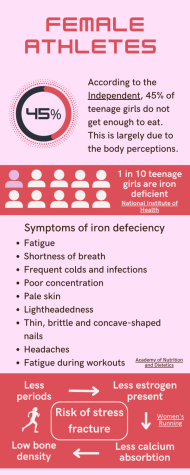Ironed out
Female athletes must ensure they get enough iron and other vitamins to perform at their best.
Most teenagers don’t think much of their diet, especially their iron intake. However, for female cross country and track runners, iron and other supplements can make all the difference between a great race and a mediocre performance.
Many women struggle with iron deficiency, especially athletes. Iron deficiency is when the body does not have enough iron, but it should not be confused with anemia. Anemia is caused when one does not have enough hemoglobin, meaning one has a low amount of red blood cells. One can have iron deficiency and anemia, but one can also have one without the other.
Iron deficiency can manifest itself in many ways, including frequent headaches, fatigue, shortness of breath, frequent colds and infections, poor concentration, pale skin, lightheadedness, thin, brittle and concave-shaped nails and irregular heart rate, according to the Academy of Nutrition and Dietetics.

Across the U.S. between 8 and 10 percent of teen girls are iron deficient according to the National Institute of Health. This is compared to just 1 percent of boys in the same age group. Because adolescent girls are going through puberty, their menstrual cycle uses up much of their body’s iron. Female athletes are especially vulnerable to iron deficiency because of the increased stress on their bodies.
Natalie Steva ’25, a track and cross country runner, started taking a supplement that includes iron last year. She can feel the difference in her performance in whether she took it that morning or not.
“I feel tired after a race [but] if I forgot to take it the day of the meet, I feel terrible afterwards,” Steva said.
Additionally, female athletes are at an increased risk for missing their period, according to the Center for Women’s Health. If severe enough, this can lead to amenorrhea (having no cycle for an extended period of time). Although it is common for athletes to skip periods during the season, they usually come back shortly into the offseason. Steva explains that while her period typically goes away during the season, she can still feel the impact of it through mood changes.
“During track season I’m not on it [my period] at all,” she said. “It’s more I get easily irritated.”
While not having a period sounds nice, it has detrimental effects. Having infrequent periods can mean not having enough estrogen. Estrogen is vital in absorbing calcium to keep bones healthy. When there is not enough estrogen, low bone density occurs, leading to shin splints, a common condition in runners.
To prevent these, female runners have to make sure they are getting enough of the right food. According to Women’s Running, female runners may have to consume up to 400 grams of carbohydrates a day. They must also ensure they are getting 3 to 5 cups of dairy each day.
While Kalli Titus ’25, a track and cross country runner, acknowledges the importance of a healthy, balanced diet, she notes it can be hard to manage an athlete’s diet in school.
“You don’t have as much time; you have 30 minutes at one portion of the day,” Titus said.
She also pays more attention to what she eats on a meet day.
“On meet days I decide to eat certain things,” she said.
Although getting enough healthy food and enough iron can be difficult, female runners have found ways to manage their diet to get the most out of their races.
Your donation will support the student journalists of West High School. Your contribution will allow us to purchase Scholarship Yearbooks, newsroom equipment and cover our annual website hosting costs.

(she/her) Yaya is a senior and this is her second year on staff. She is the sports editor and enjoys running cross country and track, making bracelets...


